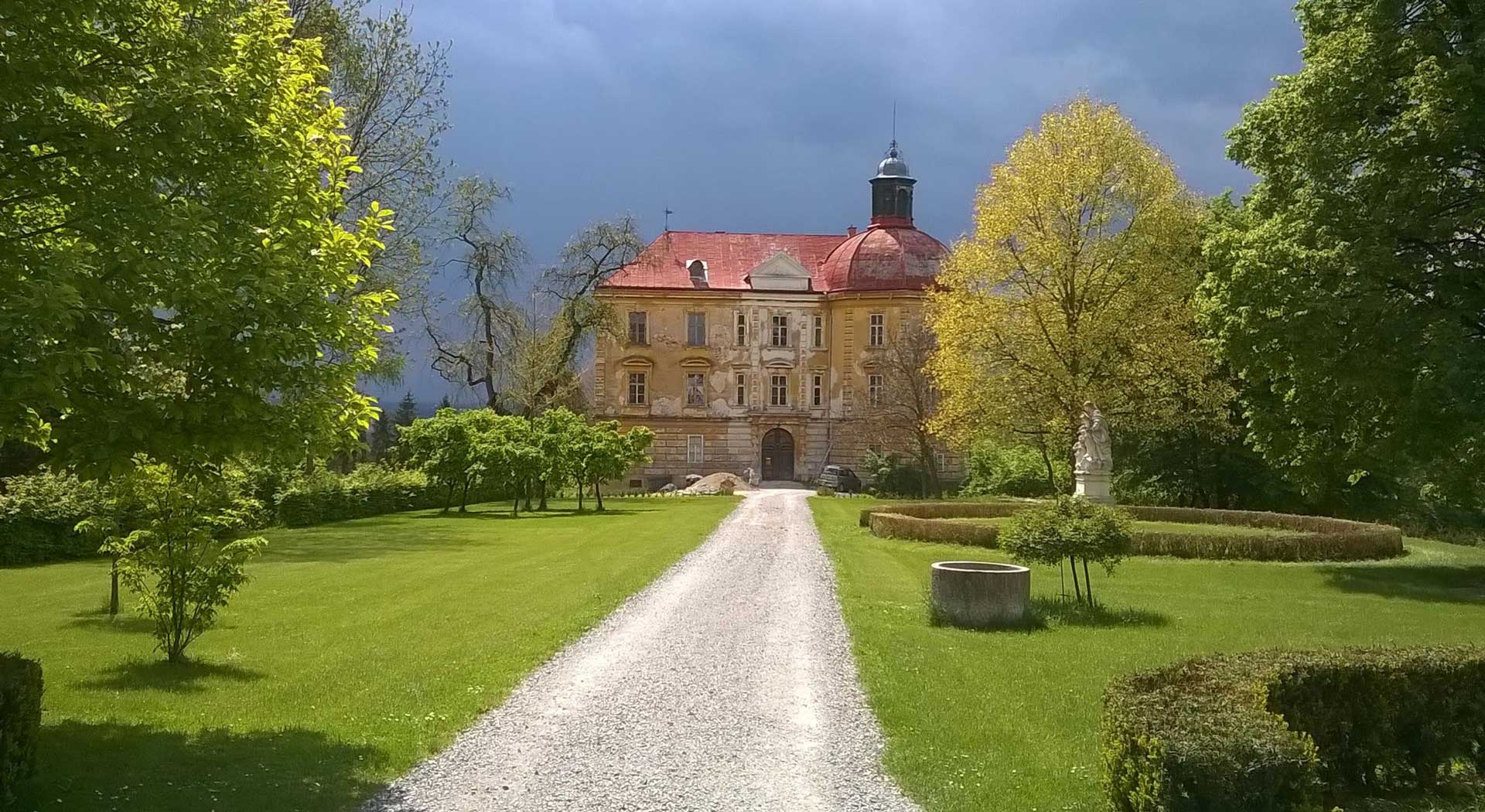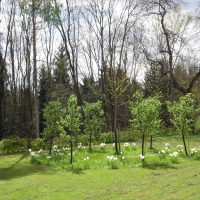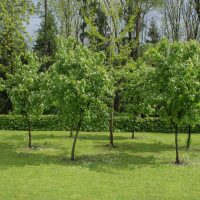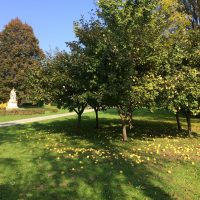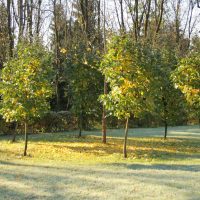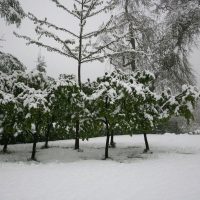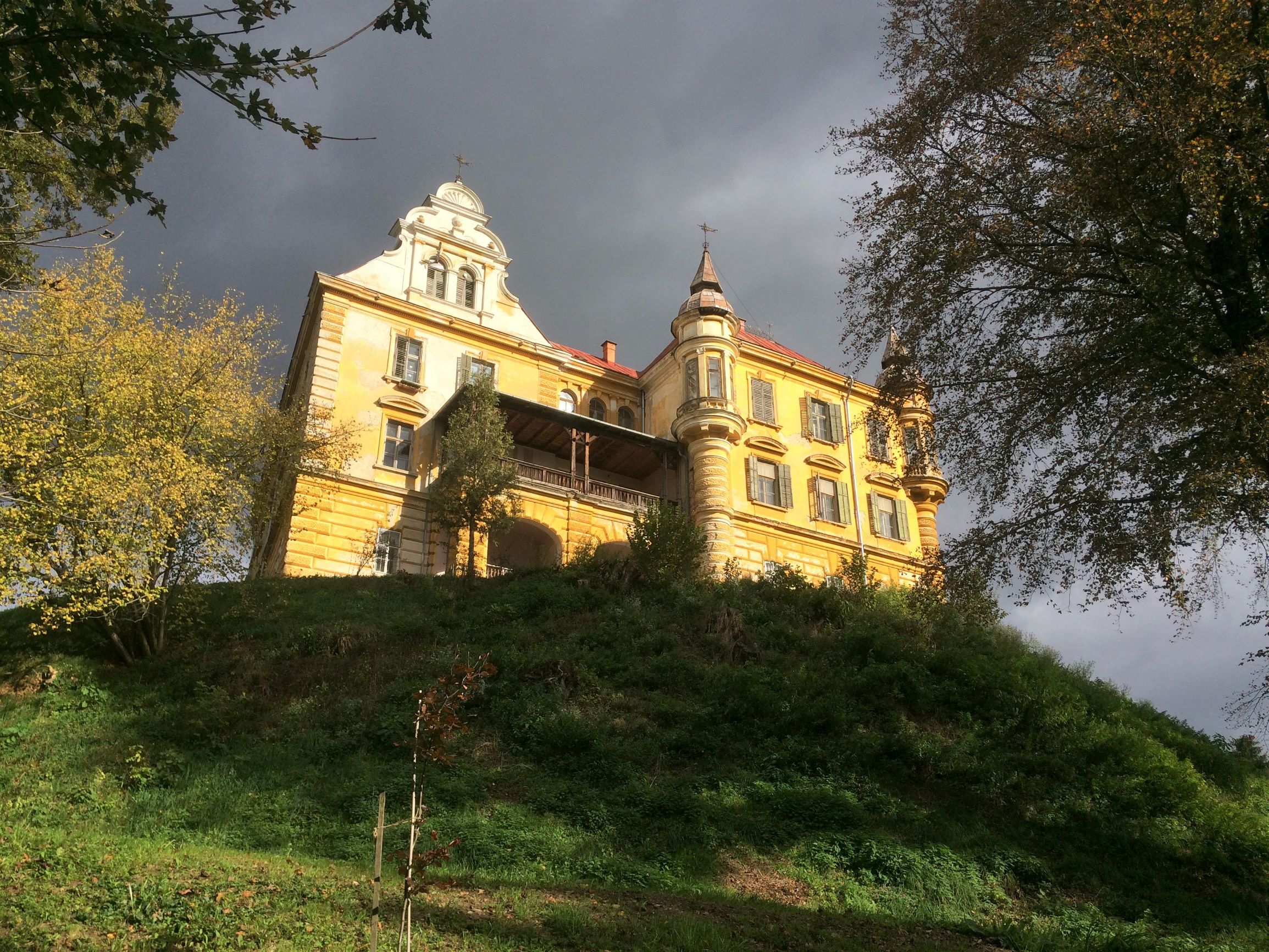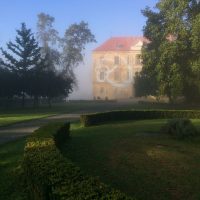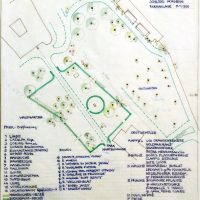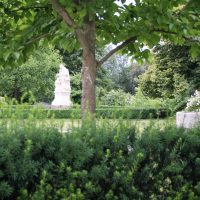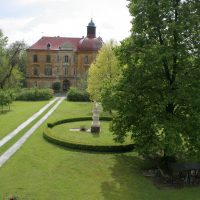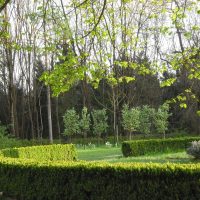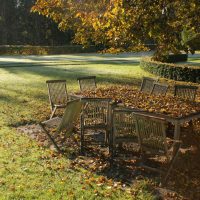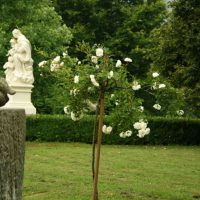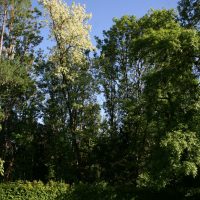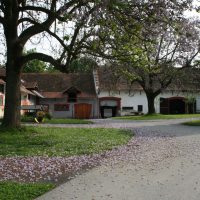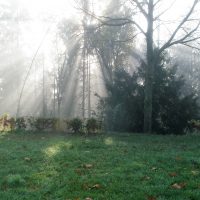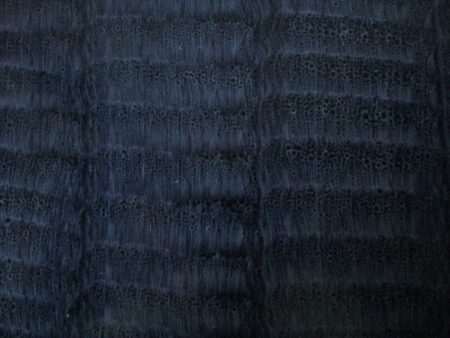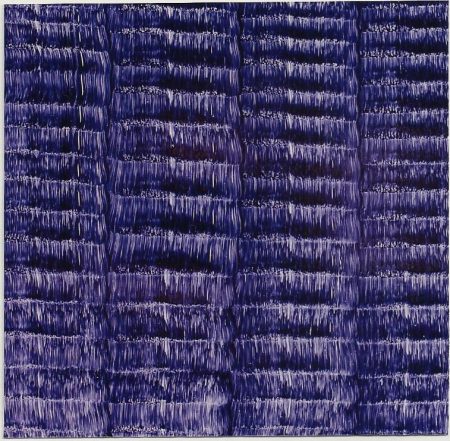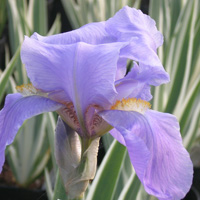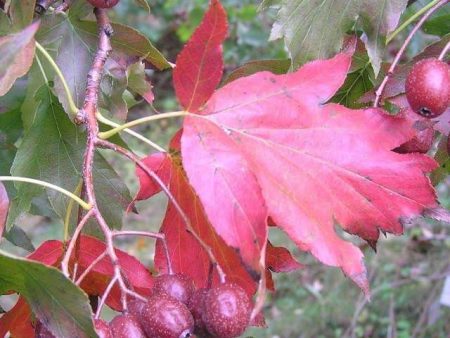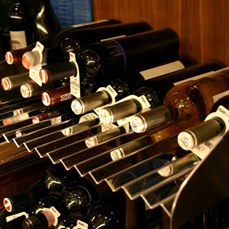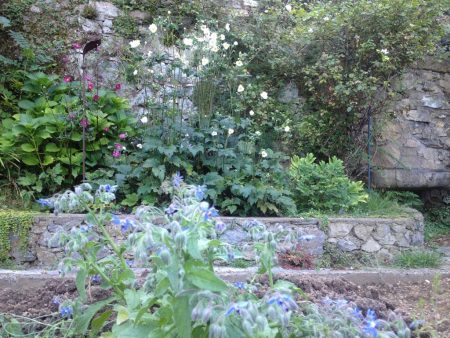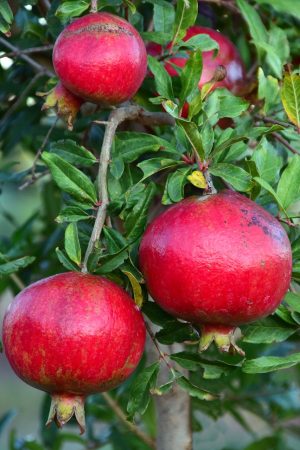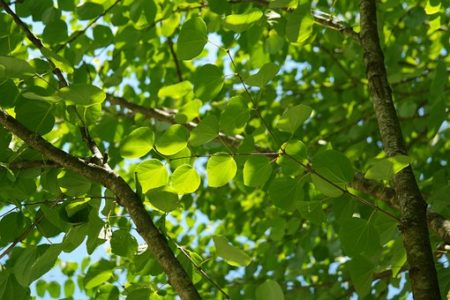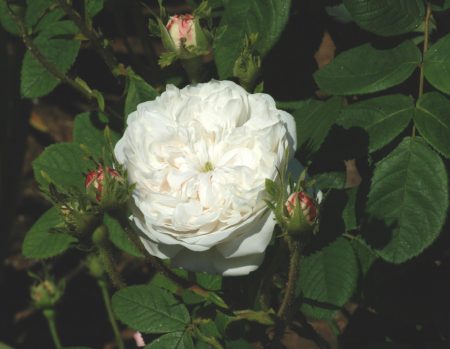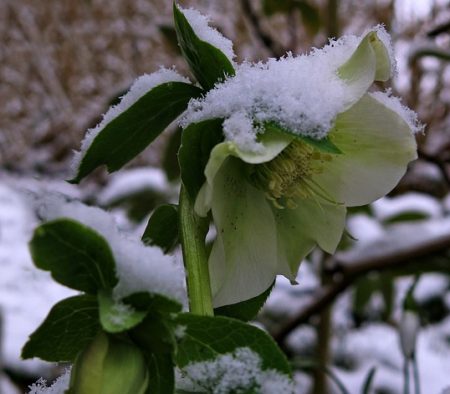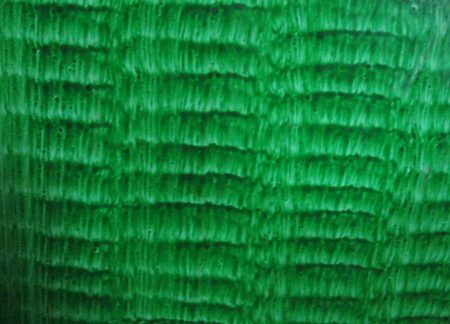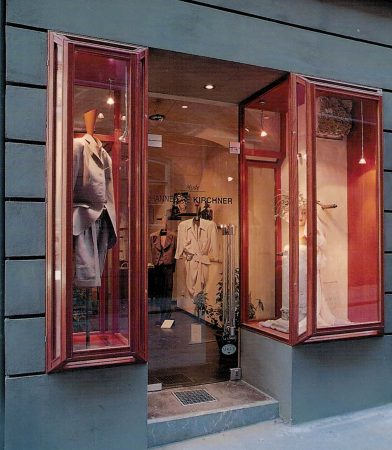The owners of Schloss Hornegg presented me with an appealing task. The aim was to restore the park around the Schloss and its hill, which had been planted in the 1960s with spruce (Picea abies), using targeted interventions to make this stately location into an enjoyable experience once again. The clients specified that the existing trees should be incorporated into the design and a layout achieved that could subsequently be maintained by the family themselves.
The space was defined and given greater importance by enclosing the park with yew hedges and also by planting hornbeams (Carpinus betulus) to the south east, down towards the woodland behind. The Baroque Sacra Conversazione, a freestanding sculpture representing Mary, the infant Jesus and St. John, located by the gravel road that crosses the park, was already clearly highlighted by a sweeping rondeau of box hedges (Buxus). This was also the case for an old weeping ash tree (Fraxinus excelsior ‘Pendula’), the tulip tree (Liriodendron tulipifera), the hickory (Carya spec.), the young ginkgo, also known as the maidenhair tree (Ginkgo biloba), a littleleaf linden (Tilia cordata), a star magnolia (Magnolia stellata) and an empress tree (Paulownia tomentosa). As a visual balance to the rondeau, I proposed surrounding the ginkgo with a ring of quince trees (Cydonia oblonga).
Circle of quinces over the seasons
The park’s circle theme was then repeated in the form of a large round well made from hewn quartz. Directly next to it we planted a white standard Swany rose, as a softer complement to balance the austere stone. Apart from the spring bulbs on the lawn and the tulips ´Purissima´ beneath the circle of quinces, this is the only flower within the enclosed park grounds. Opposite, roughly aligned with and complementing the star magnolia, we planted three dogwoods (one Cornus ´Florida´ and two C.´Kousa´).In order to open up the view down to the old plant nursery from here, two gaps were made in the yew hedge (Taxus baccata) through which the lawn could extend onto the lower level of grass. The northern gap was also flanked with two wild cherry trees (Prunus avium).
To create a shady spot, two existing catalpa trees—also known as cigartrees (Catalpa bignonioides)—were transplanted to the south of the old cistern covered with Stainz slate, joining the tulip tree and soon producing the desired effect.
Castle hill
A current project is the return of the castle hill to its historical model and the uncovering of the surviving ornamental deutzia and mock orange (Philadelphus) shrubs as aromatic plants. The Norway spruces (Picea abies) planted in the 1960s are gradually being pushed back in favour of a less dense, more light-permeable native mixed woodland. This allows the spread of naturally occurring plants such as cyclamen (Cyclamen purpurascens), European wild ginger (Asarum europaeum), snowdrops (Galanthus), spring snowflakes (Leucojum vernum), wood anemones (Anemone nemorosa), liverwort (Hepatica nobilis), crane’s-bill (Geranium), above all dusky crane’s-bill, also known as mourning widow or black widow (Geranium phaeum), ferns such as wood fern (Dryopteris) and ostrich fern, also known as fiddlehead fern (Matteuccia struthiopteris), violet leaf, perennial honesty (Lunaria rediviva) as well as annual honesty (Lunaria annua) and Solomon’s seal, also known as David’s harp (Polygonatum multiflorum), an array of colours changing with each season.
Behind a gap in the hornbeam hedge that leads through the lawn in the direction of the woodland garden, a ´Bobby James´ rambler rose is entwined in a large yew and winds across the branch of the hickory in a spectacular fashion.
The retreat of the wood reveals existing plants and paths whose appearance will keep on improving with regular maintenance.
Orchard
Making use of the microclimate of the west-facing old castle nursery, an orchard was planted to mark the birth of a child. The naturally existing difference in level from the castle park gave reason to hope that early frosts would not affect plants with moderate frost resistance. Thus I was able to take a chance on choosing rare old fruit varieties, which supply the family with an enjoyable range of fruit in attractive colours and shapes continuously throughout the summer.
Four different cherry trees: heart cherry (Prunus avium ssp. juliana) ´Bigarreau Burlat´ and hard cherries (Prunus avium ssp. duracina) Hedelfinger sweet cherry, Royal Ann and gold cherry, as well as three pear trees (Pyrus communis): Gute Luise, Clapp’s Favourite and Beurré Bosc, also four cultivated apple trees (Malus domestica): “Klachelapfel” or Red Autumn Calville apple, Gravenstein and the reinettes Goldparmäne and Cox’s Orange, together with three kinds of plum: the common plum, the Hauszwetschge or farmer’s plum, “Bosnische Zwetschke” (Prunus domestica ssp. domestica) and the large green Reine Claude (Prunus domestica ssp. rotunda), also a service tree (Sorbus domestica), a Cornelian cherry (Cornus mas) and black mulberry (Morus nigra) were planted in a lovely pattern. A hedge was composed of blackberries (Rubus sectio Rubus), raspberries (Rubus idaeus), gooseberries (Ribes uva-crispa) and currants (Ribes). A small grove of sweet chestnuts (Castanea sativa) completes the harmonious overall design of the orchard. A “nuttery” was devised with hazelnuts (Corylus avellana) and walnuts (Juglans regia) next to the house also to give the children a leafy hiding place.
Link: www.gut-hornegg.at
Other gardens: Planetary garten Eggenberg, Lindenhaus, Mediterranean garden, Woodlandgarden
